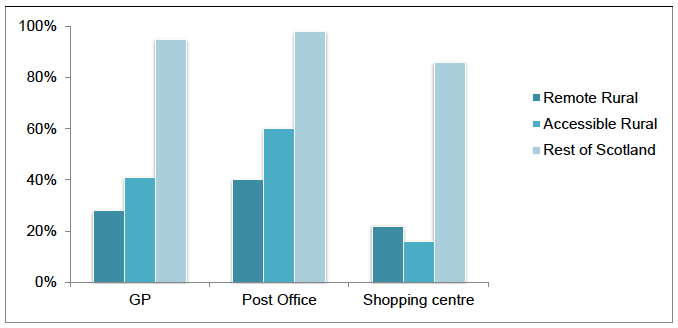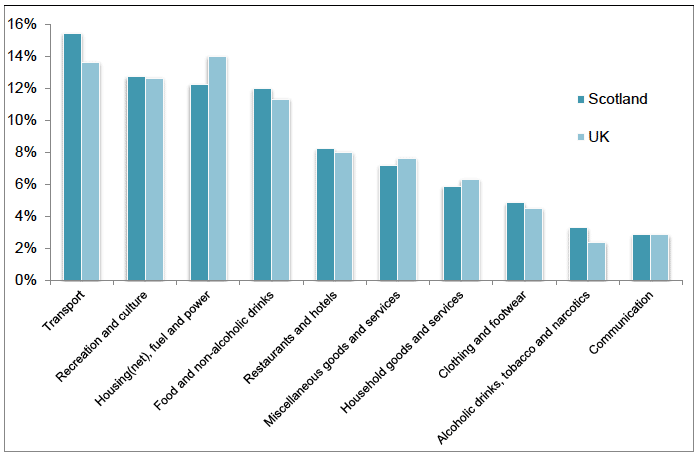Ensuring that markets work well for businesses and consumers – a strategic assessment of markets in Scotland
Our first step in identifying markets where Scottish consumers may not be getting a fair deal.
Context
Our distinct economic, social and geographic circumstances provide challenges in ensuring that competitive markets work well for Scottish consumers. The Scottish Government will seek to develop a clearer understanding of the impact that these circumstances have on markets and whether and how this impact can be addressed.
Recent Scottish Economic Developments
The Scottish economy grew by 1.9 per cent during 2015 [1] . However, the pace of growth slowed across the year - following robust annual growth of 3.1 per cent to Q1 2015, the pace of growth slowed to annual growth of 0.9 per cent to Q4 2015. Growth of 0.2 per cent in the final quarter of the year, remains below Scotland's trend rate and followed a contraction of 0.1 per cent in Q3. This slowing growth in 2015 was driven by a challenging external environment, including sterling appreciation, and exacerbated by the low oil price.
The modest growth in 2015 was driven primarily by household expenditure and public infrastructure investment. The former has been supported by the low inflation environment, high levels of employment and real wage growth; the latter has benefited from a surge in construction activities in the public sector during the year.
Recent labour market data has indicated that the ongoing challenges in the Scottish economy are impacting on the labour market. The latest Labour Force Survey statistics for February - April 2016 show that the Scottish employment rate fell by 1.3 percentage points over the year to 73.2 per cent. The Scottish unemployment rate was unchanged from a year previously, at 5.8 per cent. Alongside this, the economic inactivity (those not in work or not actively seeking work) rate rose 1.4 percentage points over the year to 22.2 per cent.
Future Outlook
Growth in Scotland was 1.9 per cent for 2015 while for the UK as a whole growth was 2.3 per cent. For 2016, independent forecasts suggest GDP growth of around 1.3 per cent is expected [2] . These forecasts represent downward revisions compared to earlier forecasts.
The Scottish consumer sentiment indicator has, however, risen slightly in the first quarter of 2016, mainly driven by improvements in expectations for economic performance over the next twelve months as well as increases in both households' current and future financial positions. [3]
Prospects for 2016 and beyond expect to see a rebalancing within investment towards private sector expenditure; similarly, the balance of growth should become broader based as improved productivity may drive export growth. Looking ahead, the positive outlook for the economy of two of the main markets for Scotland (that is, the US and rest of the UK) may favour growth. The labour market is expected to remain robust in spite of headwinds from the external environment.
Economic Context
While Scotland's economy is closely linked with the rest of the United Kingdom, the following key industries particularly characterise the economic base of the country:
- Scotland has one of Europe's largest life science clusters, with more than 670 organisations employing over 35,000 staff [4] .
- Scotland has a large abundance of natural resources from fertile land, suitable for agriculture, to oil and gas. While the fall in the oil price has affected markets worldwide, North Sea oil and gas production contributed £9.9 billion to the Scottish economy in 2015 [5] .
- The food and drink sector performs an important role in the economy, with Scotch whisky accounting for over 78 per cent of all Scottish food and drink overseas exports in 2015 [6] .
As of March 2015, there were an estimated 361,345 [7] private sector enterprises operating in Scotland, which is the highest figure since 2000. Almost the total of them (98.3 per cent) were small (0 to 49 employees); 1.1 per cent (3,870 enterprises) were medium (50 to 249 employees) and 0.6 per cent (2,295 enterprises) were large (250 or more employees). Over the last 15 years, the increase of around 50.6 per cent in the number of private sector enterprises has been driven by a significant increase of the smallest unregistered enterprises.
While the number of large enterprises is small, they still account for 44.4 per cent of private sector employment and 60.6 per cent of private sector turnover. Medium-size enterprises instead have a modest role for both employment and turnover, at just above 10 per cent.
At the start of 2015, Scotland had the fewest registered private businesses per 10,000 adults in the UK at 767, followed by 803 in Northern Ireland, 839 in Wales, 1,072 in England and 1,028 in the UK as a whole [8] . Following the same composition of the rest of the UK, last year the two largest industries in Scotland were ' Professional, Scientific & Technical Activities' (53,450 enterprises) and ' Construction' (48,135 enterprises). Together, these two sectors assemble 28.1 per cent of all private sector enterprises in Scotland.
The industrial structure of any economy is a key determinant of both its economic performance and the nature of its growth. Scotland has witnessed a shift in recent decades towards services, such as business services and finance, and away from manufacturing.
Geographic Context
Rural Scotland accounts for 98 per cent of the land mass of Scotland but only 18 per cent of the population; the rest of Scotland accounts for 82 per cent of the population and only two per cent of the land mass. Over recent years, the population of rural Scotland has continued to grow at a faster rate than the rest of Scotland, driven by the increase in accessible rural areas, mainly due to inward migration. [9]
There are significant benefits to living in rural Scotland. A higher proportion of residents of rural Scotland, compared to the rest of Scotland, rate their neighbourhood as a 'very good' place to live. However, rural consumers face a number of challenges. In terms access to services, more people in rural areas are outwith a reasonable drive time to key services compared with the rest of Scotland. Figure 2 shows that the percentage of rural consumers that have to drive over 15 minutes to reach essential services is considerable.
Figure 1: Percentage of population within 15 minute drive or public transport of service
Source: Rural Scotland Key Facts 2015

In general, a lower percentage of people in rural areas find key services convenient when compared to the rest of Scotland. This is particularly noticeable for essential services such as hospitals, dentists, chemists, public transport and banking services. For example, 58 per cent of residents of remote rural areas find public transport convenient compared to 89 per cent of residents in the rest of Scotland.
Residents in rural areas are, in general, less likely to be satisfied with public transport with 29 per cent of remote rural residents dissatisfied with the quality of public transport, compared with 12 per cent in the rest of Scotland.
Residents in rural areas are also more likely to be in fuel poverty [10] . The proportion of households in remote rural Scotland which are classed as extreme 'fuel poor' is more than double that of the proportion in the rest of Scotland (22 per cent compared to 9 per cent). Almost two thirds of households in remote rural Scotland are classed as 'fuel poor', while nearly half of households in accessible rural Scotland are in fuel poverty. In contrast, in the rest of Scotland 64 per cent of households have been classed as 'not fuel poor'.
Social Context
The population of the United Kingdom in 2014 was 64.6 million with the population of Scotland representing 8 per cent of the total population (5.3 million people). [11] Between 2004 and 2014 the percentage of the population in Scotland aged between 60-74 has increased by 17 per cent as has the percentage of the population over the age of 75. [12] The ageing of the Scottish population means that there is an increasing number of potentially vulnerable consumers who need effective protection when purchasing goods and services.
Ensuring that the benefits of economic growth are equally shared across society is important to boost the overall growth. Of the 34 OECD countries, the UK ranked 6th worst in terms of income inequality, while Scotland ranked 16th.
The social make up of Scotland is different to that of the rest of the UK. In Scotland, the cost of living is lower than elsewhere in the UK: the average weekly household expenditure in Scotland between 2010-12 was £427.30 compared with £491 in England [13] . However, this corresponds to a significantly lower median household wealth in Scotland compared to the rest of the UK. In 2014 the median household wealth was £186,600 in Scotland compared with £225,100 across Great Britain. [14]
Deprivation may also impact on consumer experiences. In 2013-14, 15 per cent of people in Scotland were in absolute poverty, with 20 per cent in absolute poverty after housing costs. [15] For these consumers, essential services reflect a significant proportion of their income and so it is essential to ensure that competition is working well. For example, in the energy market a person is said to be living in fuel poverty if, in order to maintain a satisfactory heating regime, they would need to spend more than ten per cent of their household income. The estimated rate of fuel poverty in Scotland in 2014 was 34.9 per cent. [16]
Spending on essential services, therefore, can represent a significant proportion of consumers' household expenditure, especially for vulnerable consumers. Figure 3 below shows the expenditure of Scottish households on different goods and services. Expenditure on transport represents a large percentage of consumers' expenditure, with housing costs also representing a significant proportion of household spending.
Figure 2: Household expenditure as a percentage of total expenditure, 2012 -14
Source: ONS Family Spending Survey 2014

Household expenditure varies significantly between income groups. Across the UK in 2014, lower income households spent a higher proportion of their total expenditure on food and drink than higher income households: on average, households with the lowest ten per cent of incomes spent 17 per cent of total expenditure on food and non-alcoholic drink, compared with seven per cent for the highest ten per cent of incomes. Similarly, low earning households spent nine per cent of total expenditure on electricity, gas and other housing fuels compared with three per cent for the highest income households. [17]
Household expenditure in rural areas (£567.80) was significantly higher than in urban areas (£498.40). The biggest difference in expenditure was in transport where the average weekly expenditure in rural areas was £89.20 compared with £64.70 in urban areas. This is of particular importance given Scotland's geographic landscape and likely reflects lower availability of public transport in rural areas and longer journeys to access services and amenities. [18]
ACTION: Currently, evidence on the variation of expenditure by income, age and area is only available for the UK as a whole. The Scottish Government will seek to gain a better understanding in the variation in consumer spending based on an individual's social, geographic and economic circumstances.
Contact
There is a problem
Thanks for your feedback